Home | City Notes | Restaurant Guide | Galleries | Site Map | Search | Contact
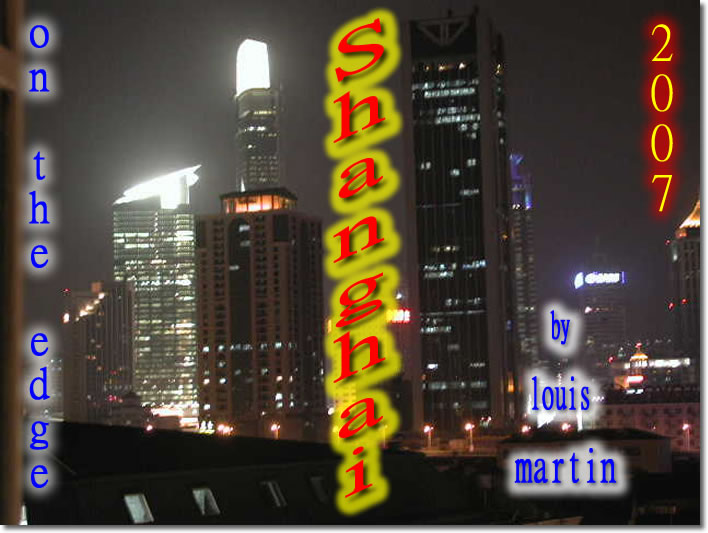
I had come to Shanghai for the dim sum. I was told by my Chinese friends in San Francisco that Shanghai has the best dim sum in the world. My plan was to spend a week tracking down dim sum, savoring its exquisite flavor, photographing it in its many forms, and taking careful notes so that I could write about it like an expert, thereby justifying my trip. That was the plan, anyway.
My first afternoon in Shanghai found me going for a walk. I may have been thinking dim sum when I started out but by the end of the walk, starting on Maoming Road, and venturing north up to Nanjing Road, then west on Nanjing, dim sum was not in my mind. The thought of dim sum had been replaced by the thought of something non-edible: architecture. Everywhere I looked there were tall modern buildings, which I usually detest. It has been my contention from living in San Francisco that architectural quality disappeared about 1950. In other words, the old was always better than the new. But now I found that contention challenged. I found myself staring, as one might stare at the Grand Canyon, at the architectural wonders on Nanjing Road. I was dazzled the night before, when taking a taxi from Pudong Airport into the city, by the lights along Huaihai Road, a major shopping route. I wrote it off as Las Vegas-like excess.
But now I was looking at another form of "excess" that I was having trouble writing off. These new buildings were the product of serious design and fine workmanship. In San Francisco these days such qualities are discussed but rarely found. As I have said before about San Francisco architecture, if a building does not collapse and it keeps the rain out, that building is good enough. Functionality is everything, aesthetics nothing. In Shanghai it is quite the opposite: Design and workmanship are everything.
I may still have had lingering thoughts about dim sum as I walked west on Nanjing Road, but by the time I got to Shanghai Center, dim sum thoughts had disappeared completely.
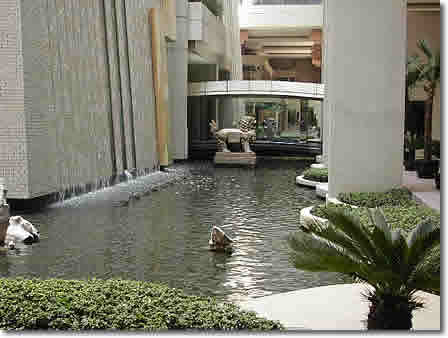
Fountains, pools of water, stately columns, sculpture, and a sheet of water flowing down the face of the building like a waterfall had me first staring, then shooting photos. But I did not just stare from a distance. I walked into the hotel lobby to get the feel of it. The feel was good. Through the lobby was a bar and a restaurant with giant columns of dark wood. Though the whole place was "ultra modern," it was also ultra inviting and ultra comfortable. Sound like a contradiction? Yes! But it seemed to be so. I didn't sit down and order a drink—and let my mind wander the misty slopes of sacred Lushau Mountain—but I felt like it.
Of course, aesthetic experiences are always followed by the mundane.
Back on the street, a young man came up with a fistful of watches.
"Look, very nice", he says. "You buy?"
Okay, so this may be the down side of all these fine new buildings: A lot of people on the street desperate to make a living. You see the discrepancies everywhere. A new city is being built on top of an old one. Is the new Shanghai going to completely replace the old Shanghai? I don't know. Construction goes on everywhere.
I walked a few more blocks west on Nanjing, then crossed the street and walked east. Everywhere I found myself staring at buildings and architectural detail, which is unusual for me. I am more of a people watcher than a building watcher, and prefer the small to the large. That said, I was happy to see a city that, if it was going to erect edifices, was at least going to treat it like a work of art and not an exercise in thrift and compact functionality. Let us just hope that at some point the construction stops and some of old Shanghai is left standing. Without the old, the new lacks definition and meaning. Or to put it more Zen-like: Too much of a good thing isn't.
Heading back down Maoming, now on the west side, I pass a door that looks like it leads to a restaurant. It is an old building, a mere two stories. My instincts are correct. Or is it my nose? There is a large room with a lot of tables. There is nothing "stylish" about this place but it is comfortable. I sit at a small table by the window. The waitress, who looks like a teenager, brings me the menu. It shows the name of the place: Di Shui Dong. The menu is bilingual but the waitress is not. She relies on smiles and guessing when there is a communication gap. I order "Beef With Onions in Chile Pot" and Tsingtao beer. For some reason she brings me the large bottle. Then the pot of beef and onions arrives in a wok set on a stand over a flame. It is very hot and the juices are bubbling. I'm curious how I am going to eat it. I try to ask the waitress but she only smiles. There is a small bowl with a large ceramic spoon on the table. I guess that will work. I spoon some into the cup and wait for it to cool. I see that I should probably have ordered rice. But I am not very hungry and don't feel like ordering rice now. Maybe the large beer will make up for the imbalance. When it is cool enough I spoon some into my mouth. It is rich in flavor and quite delicious. The oily bubbling fluids contain a lot of chopped red pepper, not only giving this dish punch but bright color. Poking around in the bottom of the wok I discover a few strips of ginger. This is no delicate dim-sum treat. It is a hardy meal that pairs perfectly with cold light beer, plenty of it.
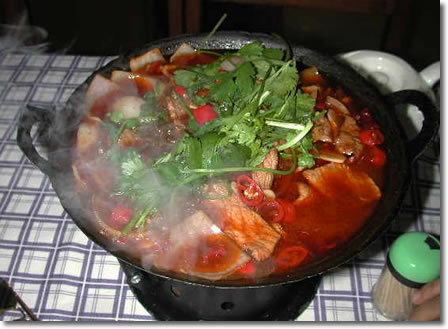
On the way back to Jin Jiang Hotel on Maoming I begin to notice old Shanghai in the narrow allies. I see bikes, piles of things, sometimes a person cooking on an open stove or sitting at a little table, face close to a bowl, eating. I would love to take a walk down one of these alleys but I do not feel comfortable doing so yet. In fact I do not even feel comfortable shooting photos of these small spaces. They belong to someone, particular people, and it would seem intrusive to do so. I have not come like the scientist to invade someone's world so I can dissect it later on for a journal. For now impressions from a distance are good enough for me.
I rest up at the hotel, then head out again later. I am interested in the Shanghai jazz scene, and want to see if I can find a place called JZ Club. It is located on Fuxing Road, which runs east-west a few blocks south of Jin Jiang Hotel on Maoming. I head down Maoming but don't come to Fuxing where I expect to. I'm at the corner of Nanchang and Maoming now. By pointing south and saying "Fuxing?" I attempt to check directions with a young man. He indicates he doesn't know Fuxing. But he begins to ask others. It is strange: No one seems to know. Finally he asks an older couple, who put up their hands like a shield, as if to say don't bother us; we don't want whatever it is you are selling. This is somewhat strange but not totally unexpected, given my earlier experience on Nanjing with the watch peddler. I say xiexie (thanks) to the young man and turn around and walk back to the hotel to have another look at the map. I see now that I have miscalculated the location of the hotel, thinking it a block more south than it actually is. From where I turned around, Fuxing was just one more block south. And why did no one on the street know where Fuxing was? There are a lot of Chinese tourists in Shanghai. You see them with maps; you see them in tour buses. They are proud of their city with the tall buildings. The young man may have been asking them, not Shanghainese.
I retrace my steps, go the extra block and there it is: Fuxing Road. I turn right and head west on Fuxing. But I don't have a good sense of relative distance in Shanghai yet, and I walk many blocks without finding JZ Club. I am beginning to have some doubts. Also, the street numbers don't make sense. The club is supposed to be at 46 Fuxing West but the numbers are still up in the fourteen hundreds. I'm beginning to think it may be a very long walk. Should I have taken a taxi on this, my first day out? But now I see an Irish pub. You can check this out. Its name is Oscar's. So I walk in, order a drink—I'm ready for one anyway—and ask the bartender if she knows JZ Club. She tells me it is just a few more blocks. "But the numbers?" I ask. "What do I know about numbers" her smiles seems to say. She pours me a Jack Daniels on the rocks and I drop my rigorous concern with numbers. If it is there, I will celebrate that and forget about the numbers.
I get a good long walk out of this and in an area of town not currently being replaced by high rises. I'm walking through the back neighborhoods of Shanghai in what I believe to be a middle-class area of apartment buildings. Most are low, old, and drab looking. They do look sturdy, however. I notice that all seem to have external air-conditioning units. I have heard that Shanghai can be very warm during the Summer. I have a Shanghainese friend in San Francisco who awhile back returned from a visit to her family with her hair cut short. "Too hot," she said, explaining the sacrifice of her long beautiful reddish-brown hair. I see these air conditioning units almost everywhere. But in April the weather is comfortable; the temperature is almost the same as in San Francisco.
Fortified by Jack, I head further west on Fuxing, a believer despite numbers indicating I had several more miles to go. But the numbers are wrong, or ten or so blocks of them are missing, because there it is on the north side of the street. And no mistaking it. With an array of glitzy lights, it stands out among the drab apartments with their air conditioners. It is a bit of the neon Shanghai tucked into a very non-neon part of town.
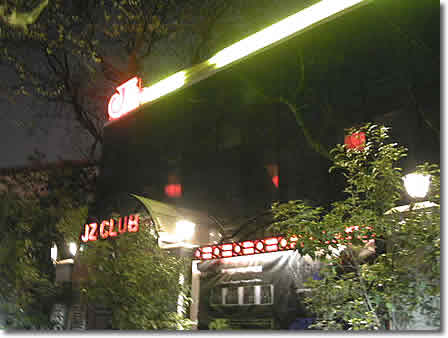
I walk in, descend a flight of stairs to the bar and talk with the bartender, who fixes me an Absolut vodka martini. They don't have Ketel One, my choice when I have a choice, but Absolut does the trick. The bartender tells me that the music begins at ten. He speaks only a little English but seems to enjoy exercising it. He tells me a bass player named "Ren" owns the club and plays there himself every Sunday. I have already looked over this week's lineup of musicians. The JQ Whitcomb Quintet is the one that interests me. From a photo I see that JQ is a serious-looking young trumpet player, thin and with a beard. I tell the bartender that I will come back tomorrow night when JQ is playing.
I leave feeling good. The club has a decent bar and a good performance area separate from the bar. Above the performance area is a small balcony providing additional seating.
I walk back to the hotel thinking about what I have seen during the day: old Shanghai, new Shaghai, little allies with age-old grime, and tall new buildings and torn-up streets with men shoveling dirt in ditches. I picture the traffic where the vehicle, whether car, bike, motor scooter, or motorcycle, seems to have the right of way always. I see cars turning into a mass of pedestrians crossing in a sidewalk with the green light and the pedestrians parting like a school of fish split into two. I am used to the pedestrian having the right of way. Although I have gotten used to the constant honk, honk, honk, ting-a-ling, ting-a-ling, ting-a-ling, I'm not sure what this is all about. Is it really necessary? At one point I begin to observe more closely. I watch a bike rider going down a back street constantly ringing his bell, even though there are no cars or other bikes near him. Maybe he finds it exciting; maybe it makes him feel important. I don't know. Later I observe cab drivers honking at cabs in front of them that are just as bound in traffic as they, the honkers, are. A nervous habit? A kind of "music" that stirs up excitement and keeps things moving? Maybe.
Although I had plans to go out later in search of dim sum, I was tired from all the walking, went back to the hotel, took a hot shower, then discovered Old Shanghai Moon restaurant in the hotel. It doesn't have dim sum but it is open 24-hours a day. That is my kind of place. At one o'clock in the morning I went up to the 11th floor where it is located and ordered "Braised Pork Patties with Crab Meat," "Yangzhou Style Steamed Dried Bean Curd Shreds," and, of course, a bottle of Tsingtao. Laziness is sometimes a good thing. The restaurant, with its chandeliers, red-velvet curtained windows, fireplace, curvaceous old hardwood chairs, the backs hand-painted with country scenes, grand piano, and photographs along the walls of Shanghai's notorious past, is a knock-out. This was before Chairman Mao changed, or at least tried to change, all that. Interesting to note: Mao Ze Dong's old residence is right up the street. He spoke Shanghainese and chain-smoked cigarettes while urging everyone else to speak Mandarin and give up their vices. As a rule, reformers are a strange bunch.

But now I'm beginning to develop a soar throat and wondering why. I don't feel sick. I think it may be the air. During the day I observed many people on bikes wearing masks. The air is "heavy" and there is little wind. If anything in Shanghai needs reform, I think it is the air.
The next day I head for People's Square. I do so less to see People's Square, more so because the way there is along "a leisurely walkway of delicacies," or I think it is. I mistake Weihai Road for Wujiang Road (the real "walkway of delicacies") and am very disappointed with the little shops selling keys, locks, toilet paper, toilet plungers, newspapers and magazines that I cannot read, sodas, cigarettes ... Yes, there is a bakery and a few small restaurants but Weihai is no walkway of delicacies. Once again I have misread the map and paid the price. However, after awhile I come to Shanghai Grand Theatre and am again dazzled by architecture.
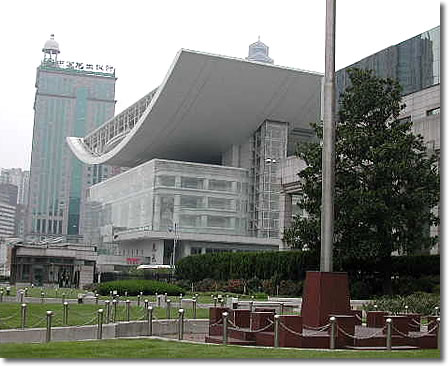
And as I progress along the way, grand become grander and grandest and grandestest ... until I find myself in the middle of People's Square, video camera in hand and slowing rotating 360 degrees counter-clockwise, recording all architecture visible from the "square," which is actually a park and less "political" in nature than one might first imagine. What a spectacle.
On the way over to People's Square I was learning more about traffic in Shanghai. I had observed that in most major intersections there were at least two traffic "controllers"; that is, real people who were dressed in uniforms and equipped with whistles which they did sometimes blow but who did little else. Truth to tell, I did not feel like their presence added much to my safety. I therefore developed a technique of my own for crossing a busy intersection. Number one, I always waited for the light. Call me chicken if you want but what many Chinese did—which was walk right out in traffic, weaving their way between cars and bikes which were totally indifferent to their presence—seemed suicidal. Number two, I waited for a group of school girls in red scarves, or a woman with a plump baby, to cross, then positioned myself on their side opposite traffic. They became my safety shield.
While on the subject of traffic and transportation, did I mention the many bikes used like trucks for hauling purposes? Those certainly did add color to the traffic scenes. It was simply amazing to see how much stuff could be hauled on a bike. A Ford pickup could do little better, and considering the traffic jams, would not have any speed advantage. And, no, I'm not making fun. I thoroughly admired these guys on bikes plowing through traffic, pollutionless, with enough material to build a small house.
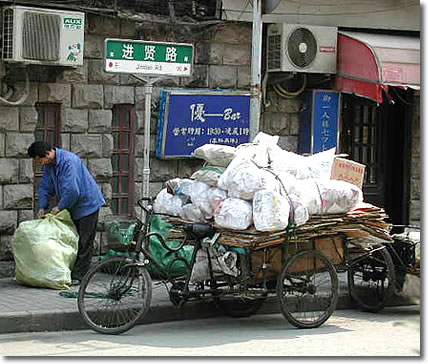
One strange scene I observed on my way to People's Square was this: A small column of soldiers out marching and heading right across the street as if traffic did not exist. I guess running over soldiers carries a heavy punishment in China, because cars, bikes, motor scooters, motorcycles—everything—stopped until they got across. Anyone else would have been instantly flattened.
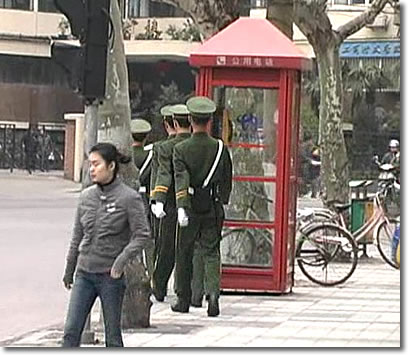
Just one other experience from People's Square: At the entrance to the park are some stands where food is sold. I told myself earlier that it was probably not a good idea to be eating food off the street, as it could contain bacteria that I was not used to. Seasoned travelers know the problem. But on the way out of the park I walked by one of the stands to take a closer look. A young woman behind a counter who was cooking some kind of little pastry balls—some kind of dumpling or jiaozi, I suppose—said hello to me and smiled. I smiled back. "You like try?" she said. The little balls, the jiaozi—whatever they were—looked delicious. I said yes. She started to prepare them with a dip, a bit of tomato, and some dark ground herb. She poked sticks into two and handed the whole batch to me in a plastic cup. They looked good, smelled great, and tasted even better. Even the "aftertaste" was good. I could taste them all the way back to the hotel. This then turned out to be my only true dim sum experience in Shanghai—not exactly what I had in mind when I began this trip but nevertheless a positive experience. Unfortunately, I was pretty unconscious of what I was doing—perhaps I had been staring at too many dazzling high-rise buildings and was giddy—and I did not think to shoot a photo or even find out what these little delicacies were called. But I can still taste them. Umm!
On the way back to the hotel, I stopped for a martini at Neo Cafe. It came in a martini glass with about a foot-long stem, and I drank it while watching the walls of the bar, which were transparent, change colors from the lights placed in back of them. The martini was fine, the bartender a young stylish Shanghainese, friendly and eager to test his English on a foreigner, but the changing colors of the walls was probably lost on me. I'm more "old school" than that.
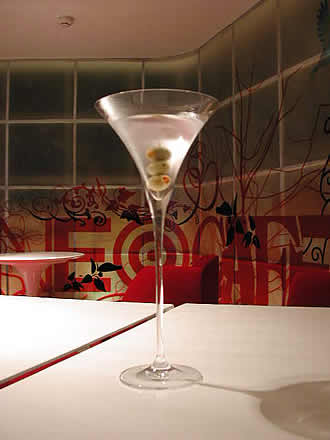
Back at the hotel I took a nap until 10 PM, then got a cab and headed to JZ Club. As I walked in the door, the band was playing. In fact, the band was sizzling. There was the fine blair of the trumpet played by JQ, the Coltrane-like lines of the tenor sax played by Alec Haavik with the tight accompaniment of guitar, drums, and organ. A singer from Amsterdam joined them for a set, doing a wonderfully coy version of "Social Call" and a gutsy, Sinatra-like version of "The Way You Look Tonight."
I caught JQ at break. He's from the United States but has lived for four years in Shanghai. He's a fine musician who plays with great control of his instrument. He is on the faculty of the JZ School, which teaches both music and language. I asked him how he liked living in Shanghai. "I love it," he said. That is kind of what I wanted to hear. My impressions were obviously superficial, only being in Shanghai a few days. But I had the feeling that it could grow on you. I could do with better air and less threatening traffic. But I wanted to know quickly if there was something there beyond the bright lights, the tall buildings, which I should point out are spread out—Shanghai is no "canyon of steel" like New York City—and bright smiling faces of young women selling dim sum in the park. Jazz always makes me feel at home, so I could not completely rely on judging Shanghai by its jazz. When I go somewhere I'm always curious to know if I would like to live there. That was the question on my mind.
Somebody introduced me to Alice Jagtman, a photographer who has just come out with a book called Shanghia Jazz, and she then introduced me to Scotty Wright. Scotty is a singer and pianist who is playing at the The Bar at the Shangri-la Hotel in Pudong. He said he was playing tomorrow evening and I told him I would try to stop by. I had not been to Pudong, which is the newest section of Shanghai, and wanted to see it. Old Shanghai, which I had been exploring, is known as Puxi. But with all the construction, it seems new too. "Two Shanghais," taxi drivers kept telling me, "Pudong, Puxi." Puxi is on the west bank of the Hauangpu River, Pudong on the east. The Bund, the center of Old Shanghai, is located on the west bank of the Huangpu across from the Shangri-la. It is the notorious Old Shanghai of the 1930s.
Friday finds me out doing what I do best: walking the streets with no particular idea in mind. First I head up Maoming, which has become my reference point or line. For me things lie east or west of Maoming, then north or south of my hotel on the corner of Maoming and Changle roads. This keeps a complex world at least manageable in my mind, and allows me to build a mental image of the city. Later, when I know the city, I discard the coordinates.
I turn west on Jinxian, a back-alley street, bigger than a narrow alley, that shows up nameless on my map. From upstairs windows there are clothes hanging out to dry. Below there are shops and little restaurants, some with only a couple of tables. I want to go in some of these places but am hesitant. On the south side of Jinxian I see a wide entrance to a building and some art outside. I walk inside and begin to look around. There are small art galleries. I begin to explore them but so far I'm not very interested in what I see other than some glossy tiles depicting country scenes. They hang on the walls outside of the galleries and I don't see any prices. I walk on wondering who I can ask about them, then find myself outside in an interior courtyard between the buildings. I look up and see a metal sculpture of an airplane made out of assorted pieces of junk.
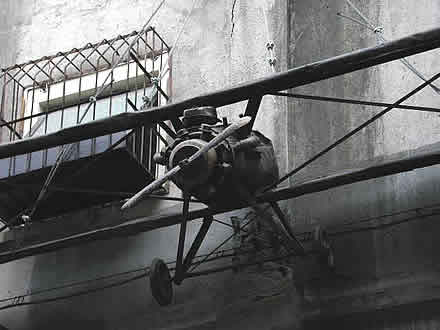
It has a creative Western look to it. Then I am back inside walking into a shop, attracted by a country scene. For some reason I am always attracted by country scenes. This one has a dog in it and some kids. I like and recommend that combination highly. Then I walk into a shop with some large works done mostly in red. I do not initially like them; they make me uncomfortable. I stare for awhile at one of the pieces. There is a young man in the shop who writes down the price for me: 6,000 yuan or about $800. When I don't buy it, he writes down 3,600 yuan or about $480. But I'm not really interested in buying it; I'm just curious. He speaks no English at all, and as my Chinese completely fails me at this point, he goes over to another gallery and comes back with a young woman. She explains that he is the artist, and we talk about the color red. It is a very Chinese color she tells me. Also there is a lot of red, I believe she says in the soil, of the artist's home town. It is a very poor region, she says. She points out the black spots on the windows of a house in one of the paintings. There is also a dog in the painting. It looks vicious to me. But then I look at it more closely and realize it looks more hungry than viscous. The black spots, she explains to me, are tears in the paper that are used instead of glass for windows, which the owners of the house cannot afford. I'm beginning to understand this piece. I look at the artist; he looks a little like the dog, eager and hungry but actually very friendly. I look at a couple of other pieces he has done. They are all well executed. One smaller red piece is abstract, whimsical.
I thank both of them and say I may come back later. I often say that, even though I know it is unlikely. It leaves a sense of possibilities and is a lot nicer than saying, "No, I'm not interested." And who knows, I may come back.
I continue west on Jinxian till I come to Shanxi Road, then head north on Shanxi. Shanxi is a main road with a lot of new, trendy shops. At the corner of Julu Road I come to a shop with English signage reading "Sex Health." I wonder what "Sex Health" is really about but don't do a lot of staring trying to figure it out. Then further up the street I encounter a few shops with English signage reading "Massage." I wonder if this means the same thing that "Massage" means in San Francisco. Earlier I passed a shop in a back alley where someone was getting a foot massage—the shop door was left open, leaving foot and masseur clearly visible from the street. The shop was not fancy. But here on Shanxi the shop exterior was glitzy, like the massage places in San Francisco. I could have pursued this further but decided to let it go. I was not in Shanghai for sex. In theory I was here for dim sum, a goal that had faded away, but I was still here for something, and I think I was finding it by just wandering around. And by getting off the main roads I was getting closer to whatever it was.
While I had given up on cutting-edge dim sum, I was still eating. And about now I noticed that I was somewhat hungry. I headed west on Julu, a back-alley street, walking by a few restaurants till I came to one that was humble, I thought, but cheerful. Inside was an older-looking woman with a teenager, probably the daughter. I walked in and sat down at one of a few tables. The mother came over and pointed to the menu, which was located under the glass table top. It was entirely in Chinese characters. I took a chance and pointed at an item. She frowned when I didn't order anything else, spoke to me in Chinese, but I understood nothing. I had the impression, however, that there was something wrong with my order. I pointed again, and she seemed to nod approval. One word, "Tsingtao," got me the beer I wanted. She brought the bottle of beer, a small one, and put in my order through a window in a door at the rear of the restaurant. Soon a heaping plate of chopped pork in a kind of sticky-sweet sauce arrived, brought over to the table by the daughter, who wore a friendly and amused smile. Then a plate heaped with vegetables arrived. Now I understood the look on the face of the mother. Simply a plate of pork or a plate of vegetables was a strange meal. Her concern was balance. While the pork was heavy with sauce and fat and rich in flavor, the vegetables were the opposite. They were light green in color, consisting of one leafy vegetable with a grassy flavor. I do not know what vegetable it was. It came in a light tangy sauce, perhaps with lemon but I'm not sure. One more devoted to the culinary arts would probably have picked this up; I, frankly, was more interested in the contrasting cheerfulness of the daughter and somberness of the mother. Would daughter become more like mother as the years passed? The daughter seemed light and free, the mother burdened. Was running a small cafe burdensome? Would a larger restaurant be more burdensome? Or was somberness just a product of age?

But back to the food: I have no idea what these simple earthy dishes were called but I left feeling satisfied.
I continued west to Maoming, then headed south on its west side. I'm headed back to the hotel when I come to another art gallery or set of them. The place looks partially under construction but it is open. I go in partly because it is my invitation to walk around in old Shanghai and its back-street shops.
In one shop I see a curious combination: Chinese paintings along with a Picasso and some Western-style reclining nude females. The clean young woman with the yellow sweater in the shop explains that Picasso is popular in China. I think I see some imitation Picassos as well. I avoid the nudes while talking with the young woman. She seems very proper. Then I spot a portrait of a ballerina that looks exactly like a painting I have seen in San Francisco by Guan Zeju. The model for the Zeju painting is Yuan Yuan Tan, principal ballerina with the San Francisco Ballet. I ask the artist's name. It is not Guan Zeju. I wonder if this is an imitation. Not seeing anything here that really turns me on, I say xiexie and move on.
Then a couple of galleries over I see a piece that really grabs me. It is a portrait of a young women with large eyes like dark pools. They have depth. I go into the gallery and there is a young woman sitting at a table. I point to the paining of the young woman and nod my head in approval. She gets up smiling. "Hen Hau" (very good), I say.
There is a whole variety of styles in this gallery but she begins to dig through a pile of paintings that is stacked up against the wall. From the pile she pulls out a similar painting of a young woman. This time the young woman has her head resting on her arm, looking pensive rather than sad, as I perceive the expression in the first painting to be. The angle is from above. She pulls out another of a blond Western-looking woman dressed in dark clothing, leather I think. Here I think we have ego and a commanding nature. There is a wrinkle in her lap which I do not understand. This is an interesting painting but I don't like it as much. I go back to the first painting. "Artist?" I ask, keeping my inquiry simple. We are both struggling for words but are able to communicate.
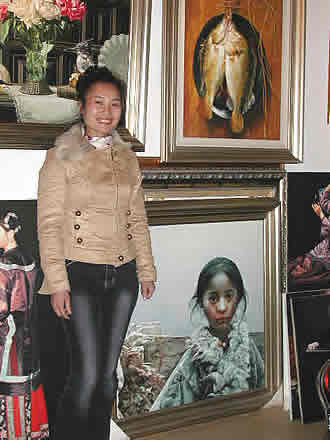
"Wo" (I), she says smiling.
"Ni jiao shenme?" (What is your name?) I ask.
She says her name is Xue Xiang Xin. She teaches me how to pronounce her name.
"Wode babe" (my baby), she says pointing to a photograph of an infant on the wall.
She asks where I'm from.
"San Francisco," I say.
"United States?" she asks.
"Yes," say.
I prefer to just say I'm from San Francisco.
I add "California" to the description of where I'm from.
She knows California and smiles. I think she has a happy image of California in her mind. Sun, oranges, sunny weather, smiling people. I'm not sure what the image of the United States is. The stupidity and stubbornness of George Bush? The old-man sour-breath life-is-death personality of Dick Cheney? The strangeness of Condoleeza Rice, who always looks like she's the center of attention at a birthday party while the world is spilling its blood due to her blunders? Maybe this is just my impression. The United States is full of contradictions. We have done great things but are killing ourselves with such elected officials, assuming they were elected.
I have fun talking with Xue Xiang. Perhaps it is the struggle of the language barrier. It takes work when you share only a few words but you feel like you have made a connection, and it is a nice feeling. We exchange cards, then I say "Zaijian."
"Nie hau" and "zaijian." These are nice expressions but there is a lot more that goes on between Hello and Goodbye.
Later I go in search of dim sum one last time, but it is a half-hearted effort. I take a walk east on Changle Road around 6:00 but most of the places are packed. Finally I come to a place, a bit on the fancier side, that is not full. I get a table, order some wine, and look over the menu. It is then that I discover that it is Thai. It see on the menu Puhket.com. I order some fish cakes that come looking great with a lovely purple flower on the plate. But the cakes are rubbery and tough. I only eat three of them. While finishing the wine and deciding what to do next, I listen to the mood music. Are they playing what I think they are? Yes, indeed.
"It's lovely weather for a sleigh ride together with you ... "
Well, it's a little early for Christmas, and we're in the wrong country on the wrong continent, but I guess this sets a positive mood—assuming you don't speak English or know the tune. I request my bill: "L'addition, s'il vous plait!" The manager comes by and asks if everything is okay.
"Sure, why not," I say.
He looks confused.
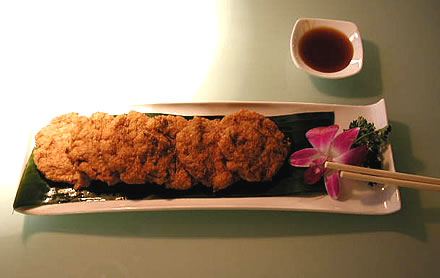
Back on Changle Road I run into a young blond woman who tries to lure me into another restaurant. It is a new Japanese restaurant that I guess is having trouble getting customers. She has a heavy accent. I ask her where she is from. France, she tell me. "Bonsoir" I say and tell her that I have just eaten Thai food and I don't want to mix it with Japanese. She is French and understands that. I tell her that I'm really looking for dim sum and she says that she thinks that's only available at lunch time but doesn't really know. That is okay. I'm not really looking for dim sum anymore. "Au revoir", I say and just go for a walk before returning to the hotel. I'm saving my energy because I want to go over later and hear Scotty at the Shangri-la.
About 10:30 I had a shot of Hennessy from the well-stocked mini-bar in my hotel room, got a taxi, then headed over to Pudong and the Shangri-la Hotel. At this hour on Friday night, the ride is dazzling. Buildings are fully lit up, and lights flash on and off, shoot up and down the sides of building, beam out into space, and dazzle the senses in every way possible. Las Vegas taste? Yes, a bit of that. But if that is what you are going to do, at least do it well. Shanghai does it like a great artist who has gone a little mad with a set of fireworks. Maybe Shanghai will sober up sometime and reform itself. But I think it would take Chairman Mao to do that and he is not around anymore.
Now while the Shangri-la Hotel has all the dazzle of Shanghai, it is also in very good taste. I think there may be a rule with hotels. Leave the neon madness out in the street. Because in the lobby of the Shangri-la, there is nothing but good taste and artistry on display. You have the same kind of respectful feeling that you get walking into the Fairmont Hotel in San Francisco, one of Julia Morgan's great works. The Shargri-la is full of golden light and rich in detail. If there is glitter, the glitter is soft harmonizing glitter. It is a work of art, rich in detail and harmonizing to the eye. In San Francisco I have often wondered where all the detail has gone. "Too expensive and no one knows how anymore anyway," a friend tells me. Not so at the Shangri-la. Someone was willing to put up the cash, and the skills, both in design and execution, were available. The result: a masterpiece. I felt like hanging out in the lobby and absorbing it into my system as an antidote to the effects of bad architecture and faulty construction but I went in search of "The Bar."
The Shangri-la has 12 bars and restaurants, but I did not have to look far. How mundane: "The Bar" is located on the ground floor just off the lobby. As I walk in, there is Scotty at the piano. There is a big bar to the right, an enclosed rectangle. There is a set of couches in front of the piano. And there is more seating off to the left, small tables I think. There is also a huge fish tank there. I chose a couch in front of the piano and settle in.
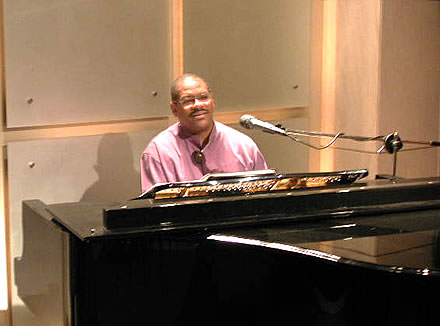
Scotty's talents match well to the Shangri-la. He sounds like a small orchestra, a one-man band, both playing the piano and singing. At break I tell him he sounds like the Duke Ellington orchestra. Both playing the piano well, I mean creatively like a real jazz musician, and singing at the same time, and I mean singing creatively, is no easy trick. In fact, I know no one else who does it really well. Lena Horn was pretty good but Scotty does it without compromise. I ask him if it was hard learning how to do this. He admits it took him awhile.
He was born in Charleston, South Carolina, but grew up in Monterey, California. He says that other than the Monterey Jazz Festival there is really not much jazz in Monterey. He's played all over: San Francisco, New York, Tokyo, Hong Kong, Shanghai ... You can read the detail here: http://www.scottywrightjazz.com/
I asked him if he had a home base these day. He said no, he just moves with the gigs. He loves the Asian gigs. He has a three-month gig at the Shangri-la, where he has played before. He loves playing Tokyo. Tokyo has been into jazz for a long time, he says. For China, jazz is newer. "They are just getting into it," he says. That is maybe the reason for the JZ Jazz School.
He says when he first moved to Shanghai a policeman followed him around. That was to make sure he was not getting paid by any other employer than the Shangri-la Hotel. He sits in places around Shanghai but does not accept money for it. "I told the police, 'You might as well send me home right now if I can't sit in.'" They did not understand the jazz tradition and did not believe he was not being paid by someone else. Finally they quit following him around.
Scotty has presence, an articulate presence with huge talent. I like this idea of moving with the gigs. Keeps things fresh, always stirred up. Alive? Alive. Aware? Aware.
Ready. Prepared. Connected. Connecting.
Chile pot, chile peppers. Red reds, dark eyes, tears. Broken heart? Mended spirit.
Ni jiao sheme?
On the way back to my hotel I see the flicker of flame from a stove on the street. I see people gathered around. Old Shanghi. New Shanghai. Balance if all goes well. Battle, otherwise. Shanghai 1930. Shanghai 2007. Legend, story, tale; chapter, paragraph, character; character, stroke, breath. Big and small:
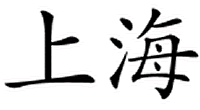
Home | City Notes | Restaurant Guide | Galleries | Site Map | Search | Contact